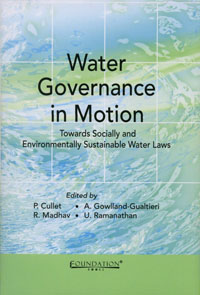/topics/wastewater-reuse-and-recycling
Wastewater Reuse and Recycling
Aerobic systems : A unique system of sewage treatment in septic tanks
Posted on 22 Feb, 2011 12:22 PMThis naturally results in two ill effects : (i) Increasing Pollution with untreated sewage and (ii) wasting of water, specially if it can be better treated and reused to an extent.
Wastewater treatment plant - Need for an affordable solution for recycling wastewater
Posted on 01 Feb, 2011 01:20 PMUtility value of world’s freshwater resources like lakes and rivers are diminishing rapidly due to over exploitation & pollution. Groundwater, an alternative to surface water is also a natural victim. The rate of ground water drawing versus its re-charge has already disturbed the natural aquifer equations.
Call for Proposals in the area of Geosciences/Seismicity - Ministry of Earth Sciences
Posted on 31 Jan, 2011 04:04 PMMinistry of Earth Sciences, the nodal agency for promotion of Earth Sciences related studies in the country, plans to launch i) a major programme in Andaman & Nicobar Island to understand the geodynamics of the region and ii) to develop damage scenarios for various Urban centers that lie in the vicinity of Himalaya.
- Proposals are solicited from scientists/academicians working in relevant areas at different institutions in the country. Proposals may be submitted to address any of the following issues:
- Crustal structure studies: delineation of deep structures by seismological (including ocean bottom seismometer), seismic, heat flow and gravity methods, and surface or shallow subsurface structures using GPR, shallow seismic, resistivity, geological methods, etc.
Blueprint for farm growth
Posted on 28 Dec, 2010 03:12 PM
Since the start of the 11th Five Year Plan, the growth rate in agriculture has virtually remained stagnant. A scene at a paddy field in the outskirts of Hyderabad.
Water management across space and time in India – A working paper by the University of Bonn
Posted on 17 Dec, 2010 10:09 PMThis working paper by the University of Bonn attempts to give a spatial and temporal overview of water management in India. It traces how people and the successive regimes made choices across space and time from a wide range of water control and distribution technologies. The paper divides the water management in India into four periods –
- the traditional system of water management before colonial times;
- response from the colonial rulers to manage the complex socio-ecological system;
- large scale surface water development after independence; and
- finally, the small-scale community and market-led revolution.
The wealth of waste: The economics of wastewater use in agriculture - A report by FAO
Posted on 17 Dec, 2010 07:36 PM This report by the Food and Agriculture Organisation (FAO) deals with the economics of wastewater use in agriculture. It presents an economic framework for the assessment of the use of reclaimed water in agriculture, as part of a comprehensive planning process in water resource allocation strategies to provide for a more economically efficient and sustainable water utilization.
This report by the Food and Agriculture Organisation (FAO) deals with the economics of wastewater use in agriculture. It presents an economic framework for the assessment of the use of reclaimed water in agriculture, as part of a comprehensive planning process in water resource allocation strategies to provide for a more economically efficient and sustainable water utilization.
Water footprint assessments of dehydrated onion products of Jain Irrigation Systems Ltd – A report by IFC
Posted on 17 Dec, 2010 07:05 PMThis work on water footprint assessments represents a pioneering effort on documenting the water consumption in Jain Irrigation Systems Limited’s (JISL) production of dehydrated onions and of micro-irrigation systems. It also assesses the sustainability of this water consumption and formulate response strategies.
e-Disha November 2010 newsletter from Consortium for DEWATS Dissemination Society (CDD)
Posted on 29 Nov, 2010 10:59 AMArticle and Image Courtesy: Consortium for DEWATS Dissemination Society

The November edition of e-Disha published by the Consortium of DEWATS Dissemination Society (CDD) has the following highlights:
Water governance in motion: Towards socially and environmentally sustainable water laws
Posted on 18 Nov, 2010 10:48 AM

Water Governance in Motion: Towards Socially and Environmentally Sustainable Water Laws focuses on the work undertaken by International Environmental Law Research Centre IELRC on water law reforms in India. It seeks to provide a broader understanding of the conceptual framework informing existing water law and ongoing reforms.
Evaluation of sanitation and wastewater treatment technologies: Case studies from India
Posted on 15 Nov, 2010 11:52 PMThe sanitation systems studied are spread across the country. The study goes to Pratapnagar in Bihar to evaluate the success of the septic tank to Asalthpur in Uttar Pradesh to study the Ecosan (UDDT) toilet. Other locations in India include Maharashtra, Gujarat, Kerala.






